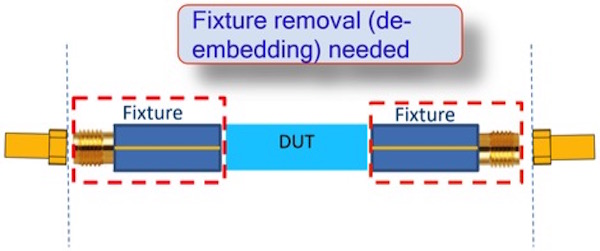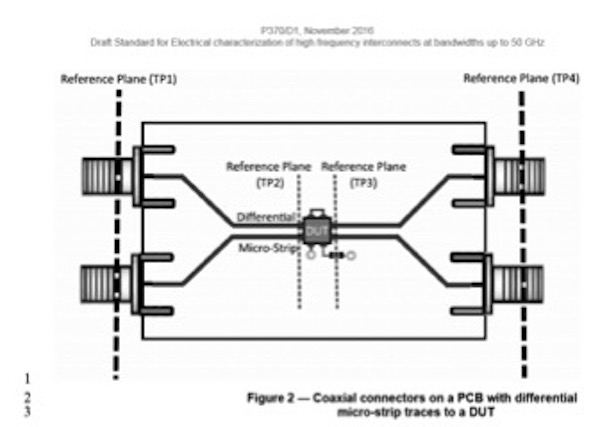At DesignCon 2017, Xiaoning Ye from Intel, the Chairman of the IEEE P370 Working Group, offered a briefing to the technical community on a new set of standards his group is developing on the electrical characterization of PCBs and related interconnects at frequencies up to 50 GHz.
A big challenge, Ye said, is in separating the fixture effects in a measurement from the interconnect itself. Figure 1 illustrates this general problem.

Figure 1. The generic problem of de-embedding the DUT measurements only while embedded in a fixture that can be measured.
While de-embedding a fixture from a composite measurement to extract the behavioral model of just the DUT is commonly done in the industry, Ye went on to emphasize that there are no standards or even recommended best practices. The industry needs a recommended set of best design practices for the fixture, established methods for verifying the accuracy of the de-embedding tool and a common methodology to check the quality of the S-parameters. This is the focus of the P370 Working Group.
The Working Group was formed in August, 2014 to draft an initial proposal to the IEEE EMC society. Once the Project Authorization Request (PAR) was approved in June, 2015, the P370 Working Group spun out three task groups focusing on the three main thrusts of the proposed standard.
The progress of Task Group 1, focusing on standards for fixture design, was presented by Jason Ellison, of The Siemon Company. One of the goals of TG1 is to “document best practices that have previously been inside knowledge in the SI community.” The fixture design strongly influences the quality of the de-embedded results. An example of a generic fixture is shown in Figure 2.

Figure 2. Example of a generic fixture which acts as a geometry transformer from the coax at the calibrated reference plane to the PCB traces of the DUT.
The fixture design itself depends on the de-embed method. One feature of the standard will be a set of S-parameter masks for the 2x thru fixture structure to assure it is transparent enough to not swamp the DUT measurement. The final details from the TG1 will describe the tools in generic terms that are used to de-embed test fixtures for each of the techniques used in industry, such as the TRL, 2x thru, 1x reflect, in-fixture de-embedding, full wave 3D simulation and port extensions.
The mission of Task Group 2, presented, by Kai Xiao, of Intel, is to create metrics for quality to validate the de-embed process and the specific de-embedded results. One technique introduced to test the quality of any de-embed algorithm is to use synthesized S-parameter models of combinations of fixtures and DUTs and the reference structures to perform de-embedding. Since the DUT model is known at the beginning, it can be compared with the de-embedded DUT as an absolute measure of the accuracy of the de-embedding progress.
Heidi Barnes, of Keysight Technologies, presented another approach for de-embedding verification using actual fabricated test boards. The idea is to have separate fixture boards and DUT boards that can be measured individually and then connected together to make any combination. Figure 3 shows an example of the first batch of fabricated boards.

Figure 3. Example of the "IEEE P370 Plug and Play Test Coupons" boards.
The measured S-parameters of the DUT board can be compared with the same DUT measured when connected to fixture boards, after de-embedding. The secret for being able to do this is the use of metrology grade adaptors which can change the sex of the connectors to enable lego-like mix and matching while maintaining the same phase delay from end to end.
Barnes is coordinating a round-robin set of measurements for different labs to compare their measurements and de-embedding methods. When the P370 Standard is released, all the synthesized S-parameter files and plug-and-play board measurements will be available as part of the standard.
The progress of Task Group 3, was presented by Mikheil Tsiklauri, of Missouri University of Science and Technology. Standard methods to measure the three quality metrics of S-parameters are being developed, including passivity, reciprocity and causality. One of the challenges in evaluating causality is transforming the frequency domain S-parameters into the time domain, in which causality is really defined. Figure 4 shows an example of the definition of causality in the time domain.

Figure 4. Example of a causal response in the time domain and two that are not.
The overall goal of the P370 Working Group is to roll into a standard the collective expertise of the industry of the best practices for designing fixtures, performing measurements and extracting S-parameter behavioral models of interconnects with minimal artifacts. With over forty experienced industry experts participating in the P370 program, there is almost 1000 person-years of expertise. We can expect valuable information from the coming standard.
For more information, visit the P370 web page, https://standards.ieee.org/develop/project/370.htm

